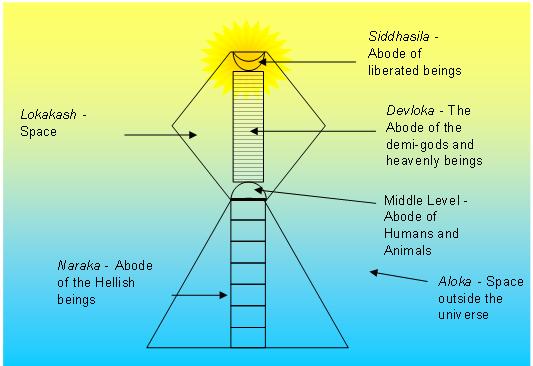Structure of the Universe
Structure of Universe according to the Jain scriptures
Jain cosmology is the description of the shape and functioning of the physical and metaphysical universe (loka) and its constituents, such as living, matter, space, time etc. Jain cosmology considers the loka, or universe, as an uncreated entity, existing since infinity, having neither beginning nor end.
The early Jains contemplated the nature of the earth and universe and developed a detailed hypothesis on the various aspects of astronomy and cosmology. According to the Jain texts, the universe is divided into 3 parts:
- Urdhva Loka - the realms of the gods or heavens
- Madhya Loka - the realms of the humans, animals and plants
- Adho Loka - the realms of the hellish beings or the infernal regions
The following Upanga āgamas describe the Jain cosmology and geography in a great detail:
- Sūryaprajñapti - Treatise on Sun
- Jambūdvīpaprajñapti - Treatise on the island of Roseapple tree; it contains a description of Jambūdvī and life biographies of Ṛṣabha and King Bharata
- Candraprajñapti - Treatise on moon
Additionally, the following texts describe the Jain cosmology and related topics in detail:
- Trilokasāra - Essence of the three worlds (heavens, middle level, hells)
- Trilokaprajñapti - Treatise on the three worlds
- Trilokadipikā - Illumination of the three worlds
- Tattvārthasūtra - Description on nature of realities
- Kṣetrasamasa - Summary of Jain geography
- Bruhatsamgrahni - Treatise on Jain cosmology and geography
The Concept of Reality - the Constituents of the Universe
This Universe is made up of what Jains call six dravya or reals or substances classified as follows:
- Jīva (Living Substances)
Jīva i.e. Souls - Soul (Jīva) exists as a reality, having a separate existence from the body that houses it. It is characterised by chetana (consciousness) and upayoga (knowledge and perception). Though the soul experiences both birth and death, it is neither really destroyed nor created. Decay and origin refer respectively to the disappearing of one state of soul and appearing of another state, these being merely the modes of the soul. - Ajīva (Non-Living Substances)
- Pudgala (Matter)) - Matter is classified as solid, liquid, gaseous, energy, fine Karmic materials and extra-fine matter i.e. ultimate particles. Paramāṇu or ultimate particle (atoms) is the basic building block of all matter. One of the qualities of the Paramāṇu and Pudgala is that of permanence and indestructibility. It combines and changes its modes but its basic qualities remain the same. According to Jainism, it cannot be created nor destroyed.
- Dharma tattva (Principle of Motion) and
- Adharma tattva (Principle of Rest) - Dharmastikāya and Adharmastikāya are distinctly peculiar to Jaina system of thought depicting the principle of Motion and Rest. They are said to pervade the entire universe. Dharma and Adharma are by itself not motion or rest but mediate motion and rest in other bodies. Without Dharmastikāya motion is not possible and without Adharmastikāya rest is not possible in universe.
- Ākāśa (Space) - Space is a substance that accommodates the living souls, the matter, the principle of motion, the principle of rest and time. It is all-pervading, infinite and made of infinite space-points.
- Kāla (Time) - Kāla is a real entity according to Jainism and all activities, changes or modifications can be achieved only through the progress of time.
- Pudgala (Matter)) - Matter is classified as solid, liquid, gaseous, energy, fine Karmic materials and extra-fine matter i.e. ultimate particles. Paramāṇu or ultimate particle (atoms) is the basic building block of all matter. One of the qualities of the Paramāṇu and Pudgala is that of permanence and indestructibility. It combines and changes its modes but its basic qualities remain the same. According to Jainism, it cannot be created nor destroyed.
